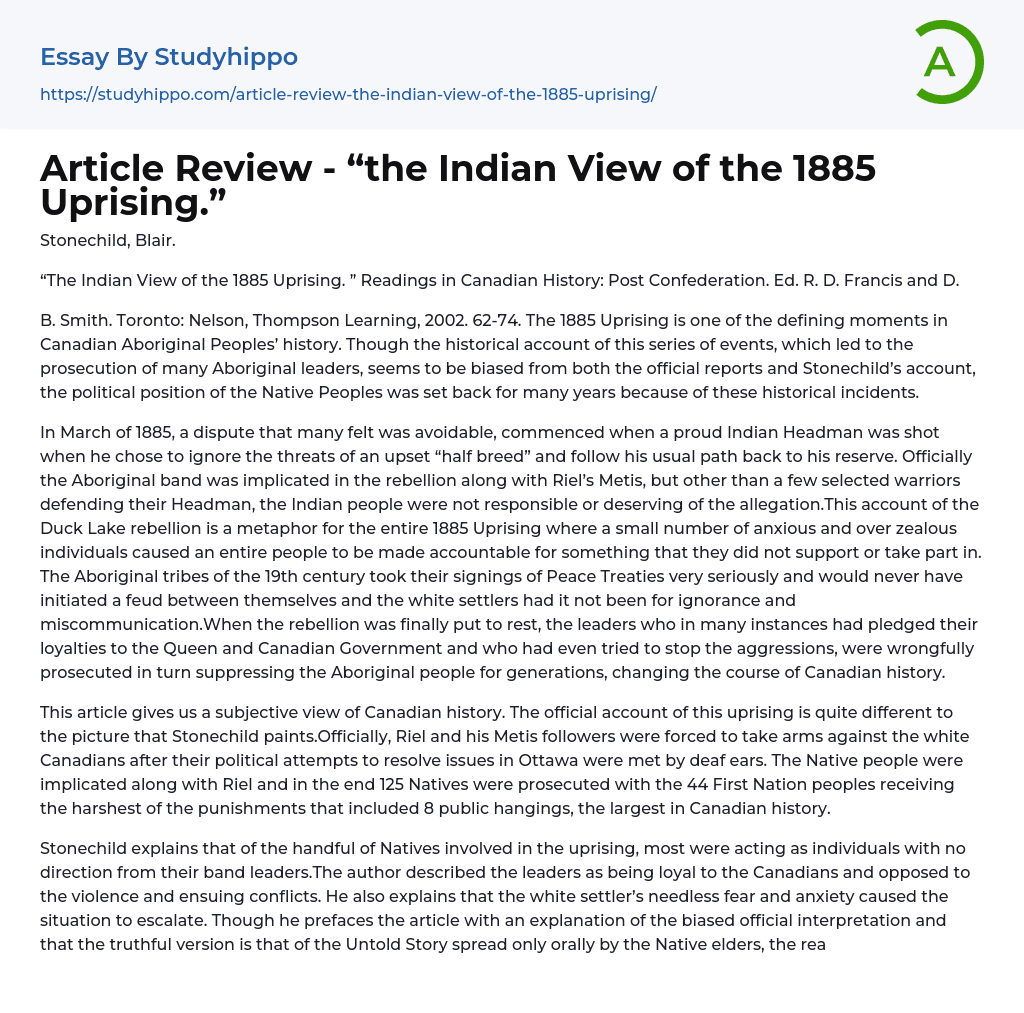

Article Review – “the Indian View of the 1885 Uprising.” Essay Example
Stonechild, Blair.
“The Indian View of the 1885 Uprising. ” Readings in Canadian History: Post Confederation. Ed. R. D. Francis and D.
B. Smith. Toronto: Nelson, Thompson Learning, 2002. 62-74. The 1885 Uprising is one of the defining moments in Canadian Aboriginal Peoples’ history. Though the historical account of this series of events, which led to the prosecution of many Aboriginal leaders, seems to be biased from both the official reports and Stonechild’s account, the political position of the Native Peoples was set back for many years because of these historical incidents.
In March of 1885, a dispute that many felt was avoidable, commenced when a proud Indian Headman was shot when he chose to ignore the threats of an upset “half breed” and follow his usual path back to his reserve. Officially the Aborig
...inal band was implicated in the rebellion along with Riel’s Metis, but other than a few selected warriors defending their Headman, the Indian people were not responsible or deserving of the allegation.This account of the Duck Lake rebellion is a metaphor for the entire 1885 Uprising where a small number of anxious and over zealous individuals caused an entire people to be made accountable for something that they did not support or take part in. The Aboriginal tribes of the 19th century took their signings of Peace Treaties very seriously and would never have initiated a feud between themselves and the white settlers had it not been for ignorance and miscommunication.When the rebellion was finally put to rest, the leaders who in many instances had pledged their loyalties to the Queen and Canadian Government and who had even tried to stop the
aggressions, were wrongfully prosecuted in turn suppressing the Aboriginal people for generations, changing the course of Canadian history.
This article gives us a subjective view of Canadian history. The official account of this uprising is quite different to the picture that Stonechild paints.Officially, Riel and his Metis followers were forced to take arms against the white Canadians after their political attempts to resolve issues in Ottawa were met by deaf ears. The Native people were implicated along with Riel and in the end 125 Natives were prosecuted with the 44 First Nation peoples receiving the harshest of the punishments that included 8 public hangings, the largest in Canadian history.
Stonechild explains that of the handful of Natives involved in the uprising, most were acting as individuals with no direction from their band leaders.The author described the leaders as being loyal to the Canadians and opposed to the violence and ensuing conflicts. He also explains that the white settler’s needless fear and anxiety caused the situation to escalate. Though he prefaces the article with an explanation of the biased official interpretation and that the truthful version is that of the Untold Story spread only orally by the Native elders, the reader is left wondering if there were parts of the Indian View that were forgotten over time.Stonechild attempts to right the wrongful depiction of the Aboriginal peoples from the 1885 Uprising.
Had his description of the 1885 Uprising been regarded during the aftermath of the conflict, there is no doubt that Canadian history would have followed somewhat of a different path and many of the Aboriginal misconceptions that are still evident today would not exist.
- Alaska essays
- Boston essays
- Brazil essays
- California essays
- Canada essays
- Chicago essays
- Costa Rica essays
- Florida essays
- Hawaii essays
- Latin America essays
- Los Angeles essays
- Mexico essays
- Slavery In America essays
- Usa essays
- Virginia essays
- Washington essays
- Bangladesh essays
- China essays
- Hong Kong essays
- India essays
- Japan essays
- Kuala Lumpur essays
- Malaysia essays
- Manila essays
- Pakistan essays
- Philippines essays
- Singapore essays
- Vietnam essays
- Vietnamese essays
- John Locke essays
- 9/11 essays
- A Good Teacher essays
- A Healthy Diet essays
- A Modest Proposal essays
- A&P essays
- Academic Achievement essays
- Achievement essays
- Achieving goals essays
- Admission essays
- Advantages And Disadvantages Of Internet essays
- Alcoholic drinks essays
- Ammonia essays
- Analytical essays
- Ancient Olympic Games essays
- APA essays
- Arabian Peninsula essays
- Argument essays
- Argumentative essays
- Art essays
- Atlantic Ocean essays



